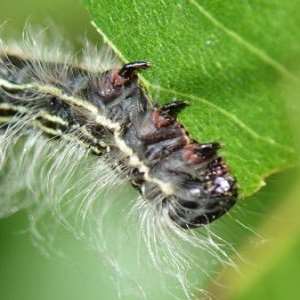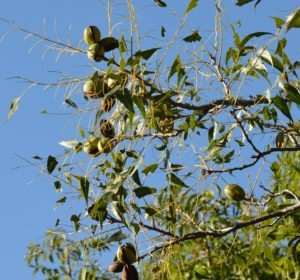By Steve Byrns
Is your nut-laden pecan tree suddenly developing a “bald spot?” The culprit is probably the walnut caterpillar, said a Texas A&M AgriLife Extension Service entomologist.
Dr. Charles Allen of San Angelo said he and his colleagues from Central and South Texas have been getting a number of reports over the past few weeks of pecan trees suddenly being denuded.

“Walnut caterpillars are often mistaken for webworms, but they don’t make a web, though they do a lot of the same things,” Allen said. “They typically hit our region in the fall and are capable of defoliating whole trees.
“That sounds pretty bad and it can be, or maybe not,” he said.
Allen said walnut caterpillars are fairly large, up to an inch or more long, dark colored with lines down the body, and they are very fuzzy or actually hairy. The caterpillars feed on the leaves of pecan, hickory and walnut trees, which Allen said are all closely related. The eggs are laid next to each other and are bright white and reflective.
When the larvae hatch, they feed in a group for several days, he said. The tree may look perfect with just a limb or two eaten bare, which he says is not a major issue. But if the tree has lots of egg clusters, chances are it will soon have lots of caterpillars and more defoliation. Even then, the fall season during which they usually hit Central Texas may be the saving grace.
“Major defoliation is always a concern, but depending on the time of the year, may not be a big problem for the tree,” he said. “Before you risk falling off your roof trying to spray the culprits, remember we’re getting to the point where it may not be as big an issue as it looks,” he said.
“That’s because the leaves become less and less functional as we move further into fall. They’re going to start falling before long anyway, so it’s not going to hurt the tree if it loses its leaves as we go further into the fall, say mid to late October for the central part of the state. We’re getting close to that point right now, so you may not need to do anything to control the caterpillars.”

For those who do want to apply some level of control, Allen said observant homeowners can take advantage of the caterpillar’ habits. As the caterpillars mature, they move down the trunk of the tree, making them easier to spray.
“You can treat the caterpillars as they reach the rough bark on the trunk,” he said. “That’s a whole lot easier than trying to treat the whole tree.”
Hose-end sprayers using a contact insecticide approved for walnut caterpillars are very effective, he said, though the rate of delivery and other label information should be closely adhered to.
“Caterpillar damage is mostly an issue of aesthetics at this point because the pecan crop is pretty much made,” he said. “At this time of year, the leaves are producing food that goes back to the roots where it’s stored and will be used next spring to push the buds and make the leaves.
“That’s really the biggest concern about major defoliation now, it’s that energy storage component. But at this time, those leaves are storing less and less energy and since the nuts are mature. In the mid fall, the food produced by the leaves is not going to the nuts themselves, but rather the tree’s roots.
“A good way to scout for impending populations is to go out at night and shine a flashlight into the tree, and those white egg masses will really shine,” Allen said. “So you can tell at night whether you have an egg-lay or not. After the eggs have hatched, typically the caterpillars clump up on a few leaves and as they get a little older, they’ll spread out from there.
“They are not poisonous and they don’t sting,” he said. “They are interesting because they react to any perceived threat by raising their head and tail and wiggling threateningly, but it’s all just for show.”
Allen said they eventually metamorph into a distinctive, rather large brown-patterned moth.
Click here to see more...